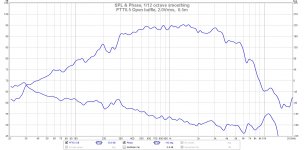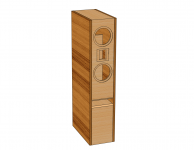What is phase? Phase just shows the time arrival of a frequency with respect to some reference. Even if you get flat phase at one point in space, i.e., all frequencies arriving together at that point, it is important to know what it is doing at other points. Ideally, you want it to sum flat at all points, which is only possible if the two drivers are really close together and are radiating omni-directionally at the frequency of interest.
Whenever the sum of the two drivers anywhere in the region of overlap is not more than the amplitude of a single driver, you know the phase responses of the two drivers are not lined up. That's what results in peaks and dips. While this in itself will be audible, and is clearly an awful trade-off to get flat phase, it will also result in peaks and dips at other points in space, i.e., away from the on-axis response. We don't want that.
Here is how a highly trained and expert speaker designer designs crossovers:
Crossover mods for the AR4x - Mods, Tweaks, and Upgrades to the Classics - The Classic Speaker Pages Discussion Forums
That thread shows how phase tracking should be done to get the best blend possible. All these other topologies are just playing tricks, but it should never be at the expense of the on- or off-axis response.
Also, some words of wisdom here:
The importance of phase tracking
Also, the best speakers in the business, think JBL M2 and Revel Ultima Salon 2, employ all manner of crossover topologies with phase shifts. Doesn't seem to affect their sound. If you use JRiver or miniDSP or similar, you can play with phase independently of amplitude.
Whenever the sum of the two drivers anywhere in the region of overlap is not more than the amplitude of a single driver, you know the phase responses of the two drivers are not lined up. That's what results in peaks and dips. While this in itself will be audible, and is clearly an awful trade-off to get flat phase, it will also result in peaks and dips at other points in space, i.e., away from the on-axis response. We don't want that.
Here is how a highly trained and expert speaker designer designs crossovers:
Crossover mods for the AR4x - Mods, Tweaks, and Upgrades to the Classics - The Classic Speaker Pages Discussion Forums
That thread shows how phase tracking should be done to get the best blend possible. All these other topologies are just playing tricks, but it should never be at the expense of the on- or off-axis response.
Also, some words of wisdom here:
The importance of phase tracking
Also, the best speakers in the business, think JBL M2 and Revel Ultima Salon 2, employ all manner of crossover topologies with phase shifts. Doesn't seem to affect their sound. If you use JRiver or miniDSP or similar, you can play with phase independently of amplitude.
Last edited:
In my other thread with PTT6.5 and an RS28F in waveguide, I also used a passive Harsch XO at 3500Hz. Yes, it still has the same little dip to the left of the XO point, but the off axis response looks great.
Simple Passive Harsch XO Using PTT6.5 and RS28F in a Waveguide
Here is the measured on axis response for both drivers and sum:
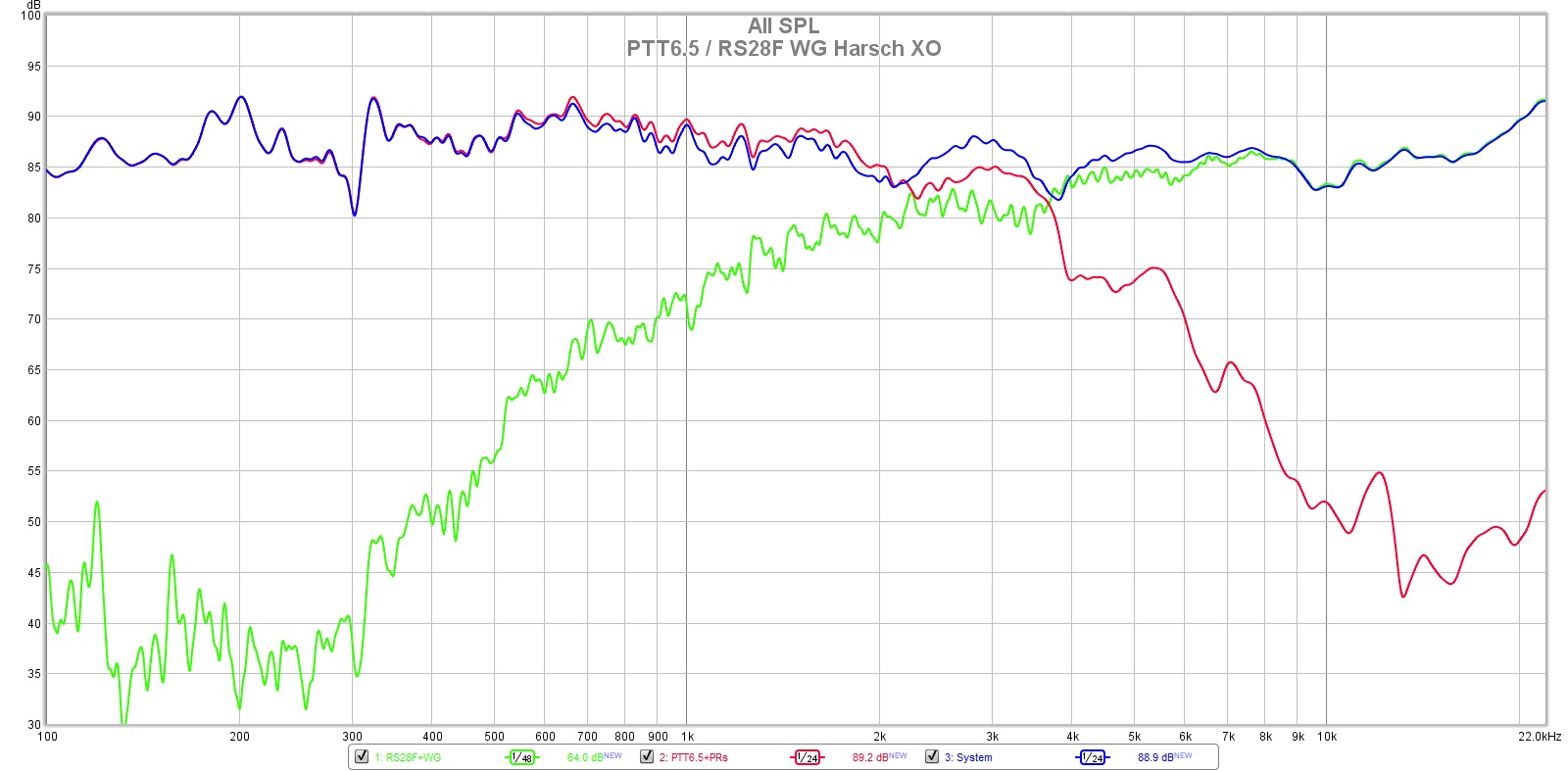
And here are the polars showing basically flat response over +/-30deg:
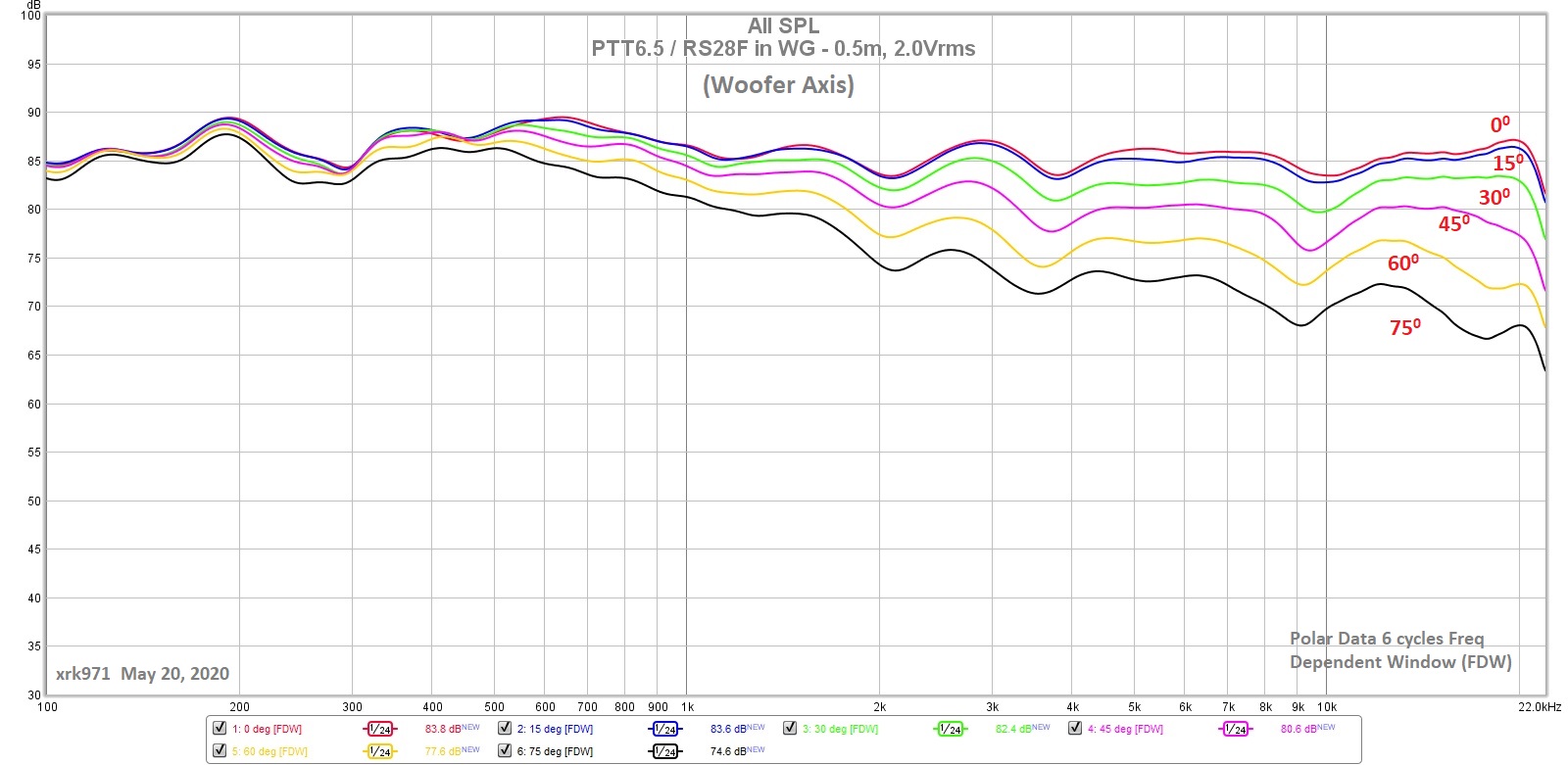
Here is what SpeakerDave said about phase tracking in the cited thread:
The phase of the system should vary smoothly at the XO region, and ideally be about halfway between the starting and end phase points.
The predicted system phase for this speaker seems to vary smoothly but instead of monotonically changing through the XO region, it has mild rounded bump or hill up 60deg or so and back -60deg for an overall level phase response.
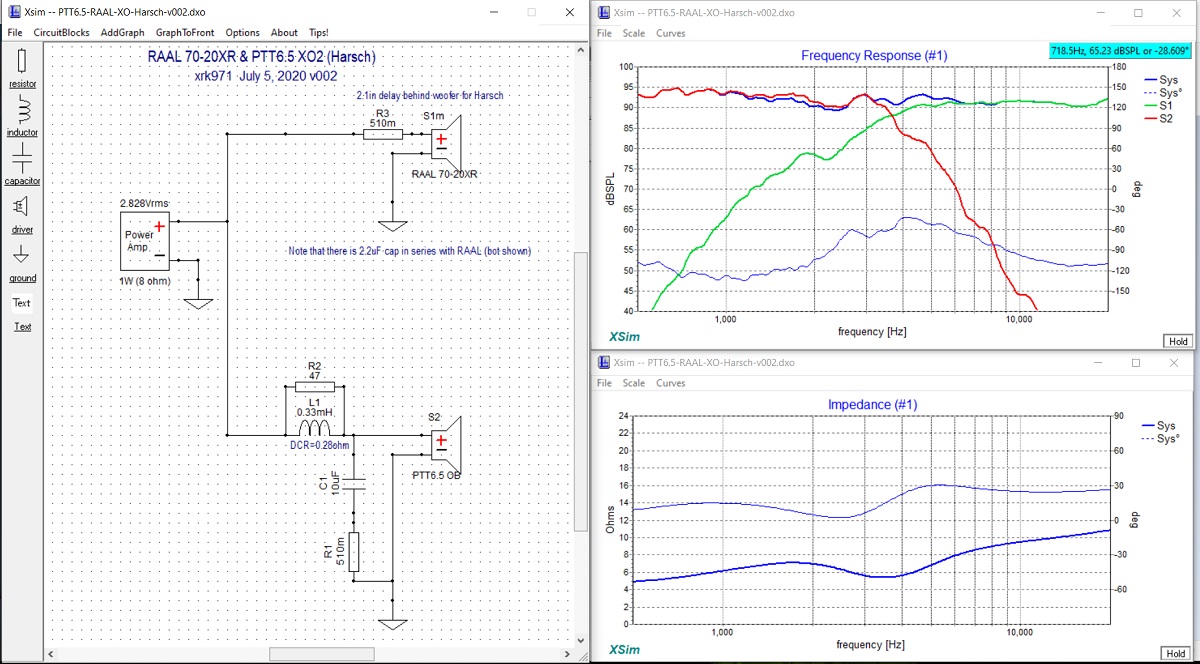
Simple Passive Harsch XO Using PTT6.5 and RS28F in a Waveguide
Here is the measured on axis response for both drivers and sum:
And here are the polars showing basically flat response over +/-30deg:
Here is what SpeakerDave said about phase tracking in the cited thread:
More than anything the audible effect will be the impact of phase blend on the combined frequency response. Others will try and mystify the phase effect, but should remember that the overall phase response of the system is minimally changed by the phase spread between two units. The combined phase response in the crossover region is essentially half way between the two starting phase curves (it transitions smoothly from one to the other) and improving the phase "closeness" doesn't change the overall group delay of the system (these are facts).
The phase of the system should vary smoothly at the XO region, and ideally be about halfway between the starting and end phase points.
The predicted system phase for this speaker seems to vary smoothly but instead of monotonically changing through the XO region, it has mild rounded bump or hill up 60deg or so and back -60deg for an overall level phase response.
Last edited:
I agree that an improperly designed crossover that may be flat by has tons of phase shift sounds bad - I call it “phasey” and it is more apparent when I rotate my head at an angle.
This is not what I'm talking about. An improperly designed 2nd or 4th order LWR will still exhibit the same degree of phase shift, from the start to the end of the audio band, as a properly designed one.
The difference is that the properly designed LWR will have the two drive units summing entirely constructively throughout the crossover region, especially for the target design axis. Whereas the improperly designed one will not with the phase integration being a mess. This typically shows up as a poor reverse null and regions where the amplitude summation of the two drivers are causing destructive interference.
With really bad designs you can't even tell which polarity is supposed to be the reverse null because both the 'correct' polarity and 'inverted' are in such misalignment, to what they are supposed to be, that neither looks like it's supposed to. Even so the summation can appear reasonably flat with the polarity flipped either way. But with both, the reverse and correct polarity, showing regions of constructive and destructive interference throughout the crossover region. This sounds bad with diffuse imaging and the 'phasey' type sound you talked about before.
But if the acoustical phase (as measured by a mic or heard by our ears) is flat through this “messed up” region, how do you hear it?
I really am not completely sure. Why does a botched LWR, like described above, sound diffuse and confused/phasey, when it's frequency response is reasonably flat? My guess is that the offaxis and early reflections, combined with the poorly integrated drivers just creates a mishmash of poorly integrated wavefronts that distorts our perception with regards to imaging.
It's like people arguing for first order designs and transient perfect stuff. You're only getting that square wave at one specific axis though. As soon as you go away from this bye bye square.
I have tried this with DSP by adding lots of phase wrap but keeping response flat. It’s audible and annoying. However, here, the phase shift is a gradual 55deg rise and fall. Not so audible.
You can add in lots of phase wrap to a speakers measurement by moving the start of the gate further away from the start of the impulse. It's just time. Sit further away from the speakers and there's more time between the sound being created at the speakers and it reaching your ears. You can add in 10ms of delay with a DSP or you could move the gate, or you could sit further away.
Horizontal 😕And here are the polars showing basically flat response over +/-30deg:
Yeah, vertical polars get messed up. Tinkering with vituixcad I've noticed best vertical response is when phases of individual drivers track each other closely, as speaker dave in the link says.
Yes, Speaker Dave is very knowledgeable.
I don't think that's what he is saying here. I believe he first says that the response is the more obvious effect, and people don't consider this when they talk about phase because it isn't phase, per se, they are actually hearing. He then goes on to say that system phase is based on a combination from the two sources (in the crossover region).
I don't think that's what he is saying here. I believe he first says that the response is the more obvious effect, and people don't consider this when they talk about phase because it isn't phase, per se, they are actually hearing. He then goes on to say that system phase is based on a combination from the two sources (in the crossover region).
This has so far been a delicate topic with many aspects so I don't want to bound in with any general statements.
5th, with regard to the treble being in phase it kind of doesn't count because of what it had to do to get there. In cases like this I find it better to look at group delay, which is basically the same phase information put differently.
Oh yes, there may be a general statement here. If more than one driver is used, they MUST work together and add output. If they start working against each other, the design is not good. Everything else is a matter of design.
What do you mean working together, is it ok for them to be...
20 degrees apart?
90 degrees apart?
135 degrees apart?
20 degrees apart?
90 degrees apart?
135 degrees apart?
Hello xrk,
In post 62 you show the filtered driver responses on axis in a very different graphic presentation than the heavily smoothed off axis curves.
Is it much to ask to show the off axis curves in exactly the same way as the filtered drivers, that is ( I think) 1/48th and no fdw?
In post 62 you show the filtered driver responses on axis in a very different graphic presentation than the heavily smoothed off axis curves.
Is it much to ask to show the off axis curves in exactly the same way as the filtered drivers, that is ( I think) 1/48th and no fdw?
What do you mean working together, is it ok for them to be...
20 degrees apart?
90 degrees apart?
135 degrees apart?
Sum must be positive! Drivers should not cancel each other on listening spot!
Hey X,
Just chiming in as someone who picked up a pair of the 70-20 when it came up on the swap meet last year, after hearing them in a commercial speaker at a show.
We have built a set of Jeff Bagby's Kairos speaker, his transient perfect two-way, and when I saw that you figured out a Harsch XO with the RAAL and Purifi, well...
Did you happen to measure your open baffle response low enough to see when the OB fall off occurred? I was thinking about putting your front baffle and crossover on top of an LXmini lower, at a lower crossover frequency that would allow a first-order slope to line up with the Purifi's falloff. Hopefully it will still combine to be cardioid over a wide range, and bring transient perfect to the LXmini. The excursion on the Purifi should allow 300Hz or lower, based on SL's OB Xmax spreadsheet
Thanks for all the inspiration!
Just chiming in as someone who picked up a pair of the 70-20 when it came up on the swap meet last year, after hearing them in a commercial speaker at a show.
We have built a set of Jeff Bagby's Kairos speaker, his transient perfect two-way, and when I saw that you figured out a Harsch XO with the RAAL and Purifi, well...
Did you happen to measure your open baffle response low enough to see when the OB fall off occurred? I was thinking about putting your front baffle and crossover on top of an LXmini lower, at a lower crossover frequency that would allow a first-order slope to line up with the Purifi's falloff. Hopefully it will still combine to be cardioid over a wide range, and bring transient perfect to the LXmini. The excursion on the Purifi should allow 300Hz or lower, based on SL's OB Xmax spreadsheet
Thanks for all the inspiration!
I’m sure I have the data for the open baffle bass fall off. Probably about 400Hz or so. Let me dig it up.
Thank you, if you find it that's great, I'm mostly interested if there was the ~few dB rise before the fall-off, that SL notches out when there's no baffle.
I also picked up a pair of the Viawave GRT4 on swap, I'd send them to you if you were interested in evaluating them. At least they're actually commercially available. I don't have the ones with waveguides, although those might be perfect for your 2.1" offset.
Sidenote, but I've been reading today about how to repurpose a 6.5" Satori in your 0.53 Karlsonator. The reduced displacement will be a nice way to sidestep all that IMD that the Purifi review on HiFiCompass illustrated 🙂
I also picked up a pair of the Viawave GRT4 on swap, I'd send them to you if you were interested in evaluating them. At least they're actually commercially available. I don't have the ones with waveguides, although those might be perfect for your 2.1" offset.
Sidenote, but I've been reading today about how to repurpose a 6.5" Satori in your 0.53 Karlsonator. The reduced displacement will be a nice way to sidestep all that IMD that the Purifi review on HiFiCompass illustrated 🙂
Last edited:
Where is there a discussion if a Satori in a Karlsonator?
The Viawave ribbon looks like a great driver.
The Viawave ribbon looks like a great driver.
Here is the PTT6.5 response measured in the narrow OB at 2.0Vrms and 0.5m on the woofer axis. The signal seems high, and I was never able to debug what was going on - but sensitivity seems about ~5dB too high as it should be 88dB at 2.0Vrms and 0.5m (same as 2.83vrms and 1.0m). But there is no OB overshoot peak. It is quite well behaved and would be very easy to integrate to a woofer at 300hz to 400hz.

Attachments
Thank you! Yeah, that looks really promising for a simple 1st order to the woofer, maybe it's even possible to just LP the woofer and offset the OB for phase. Either way, should be fun and I'm finally ready to purifi my wallet and jump in on OB experiments with them.
As for the Karlsonator & XKi, what I meant was that I have been checking parameters & box sizes for a few drivers on hand. It always helps to have another use for them in the wings if the "next idea" works out. 🙂 I saw your nice guide on Akabak, just didn't realize about version 2, have to get back to XP for it.
Thanks again, and I'll pm you about sending drivers to investigate
As for the Karlsonator & XKi, what I meant was that I have been checking parameters & box sizes for a few drivers on hand. It always helps to have another use for them in the wings if the "next idea" works out. 🙂 I saw your nice guide on Akabak, just didn't realize about version 2, have to get back to XP for it.
Thanks again, and I'll pm you about sending drivers to investigate
Floorstanding Dual PTT6.5-8 and RAAL 70-20xr TL Design
I just completed the design of a dual Purifi PTT6.5-8 (new 8ohm variant) with a RAAL 70-20xr tweeter in a WTW floorstanding TL. The 8ohm woofer is a tad bit less sensitive so two in parallel only buys about 2dB more sensitivity after baffle step losses. Howver, they can achieve higher SPL's before distortion sets in. This tapered TL is based on a similar design used by my 10F/RS225 FAST TL speaker.
The speaker is 45in tall x 9.5in wide x 18.5in deep. The TL achieves 86dB sensitivity in 4pi space at nominal 4ohms with -3dB at 36Hz and -6dB at 28Hz. Group delay at 50Hz is only 5ms (same as a sealed box).

Predicted Freq Response:

Predicted Impedance (woofers only):

Predicted GD:

I think the woofers will integrate perfectly with the RAAL using a similar XO to what is discussed in this thread. If you interested in this design, send me a PM.
I just completed the design of a dual Purifi PTT6.5-8 (new 8ohm variant) with a RAAL 70-20xr tweeter in a WTW floorstanding TL. The 8ohm woofer is a tad bit less sensitive so two in parallel only buys about 2dB more sensitivity after baffle step losses. Howver, they can achieve higher SPL's before distortion sets in. This tapered TL is based on a similar design used by my 10F/RS225 FAST TL speaker.
The speaker is 45in tall x 9.5in wide x 18.5in deep. The TL achieves 86dB sensitivity in 4pi space at nominal 4ohms with -3dB at 36Hz and -6dB at 28Hz. Group delay at 50Hz is only 5ms (same as a sealed box).
Predicted Freq Response:
Predicted Impedance (woofers only):
Predicted GD:
I think the woofers will integrate perfectly with the RAAL using a similar XO to what is discussed in this thread. If you interested in this design, send me a PM.
Attachments
@XRK971, looks like it could be a winner, did you try using the new “W” version of the woofer rather than the older “X” version. This has less xmax but a bit more sensitivity?
No point using W version, when using dual x. Dual x woofer itself already increase sensitivity.
I am more interested if we use it in dual chamber reflect cabinet with passive radiator in bass section instead of ported
I have a gut feeling Gryphon mojo s, customised seas 6 inch seas woofer is similar is purifi version , but the crossover is base on duelun design with simple ported cabinet.
Any listening impression ?
I am more interested if we use it in dual chamber reflect cabinet with passive radiator in bass section instead of ported
I have a gut feeling Gryphon mojo s, customised seas 6 inch seas woofer is similar is purifi version , but the crossover is base on duelun design with simple ported cabinet.
Any listening impression ?
Last edited:
- Home
- Loudspeakers
- Multi-Way
- RAAL 70-20xr and PTT6.5 Compact TL
